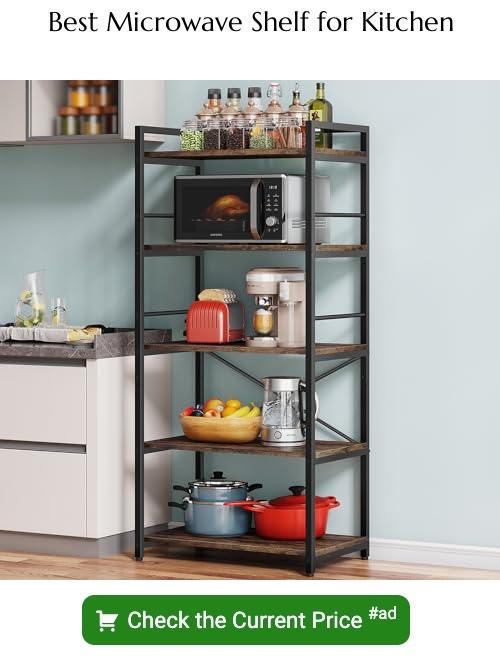Last updated on
Discover the perfect spot for your microwave in the kitchen with our insightful guide, offering practical tips and ideas to maximize efficiency and aesthetics.
Microwaves have become an essential appliance in every kitchen. They make cooking and reheating food a breeze, saving us time and effort.
However, with the limited space in most kitchens, finding the perfect spot to place your microwave can be a challenge. Placing it on the countertop may take up valuable workspace, while mounting it above the stove may not be practical for everyone.
In this article, we’ll explore different options for where to place your microwave in the kitchen, so you can find a solution that works best for your needs and space limitations. So let’s dive in!
What's Inside
Assessing Your Kitchen Layout
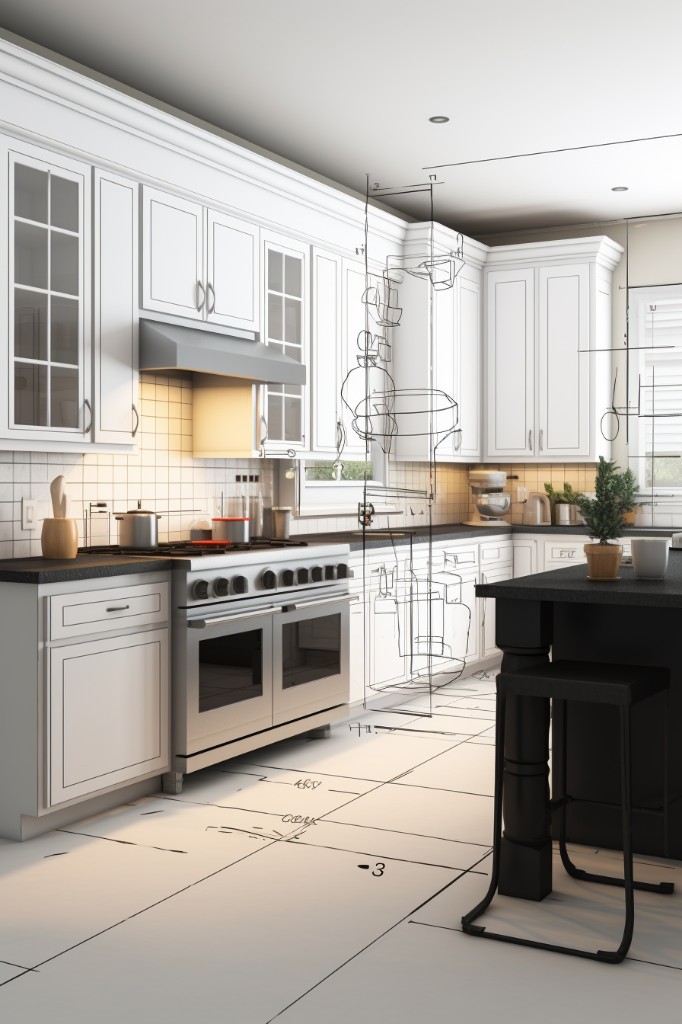
Before deciding where to place your microwave in the kitchen, it’s important to assess your kitchen layout. Consider the size of your kitchen and available counter space, as well as how you use your microwave on a daily basis.
Do you primarily use it for reheating leftovers or cooking full meals? Will multiple people be using the microwave at once? These are all factors that can influence where you choose to place it.
Take note of any existing appliances or cabinets that may impact placement options. For example, if you have a range hood above your stove, an over-the-range installation may not be feasible without making significant modifications.
Consider safety guidelines when assessing potential locations for placing a microwave in the kitchen. Avoid placing microwaves near heat sources such as stovetops or ovens and ensure there is enough ventilation around them.
Microwave Placement Options
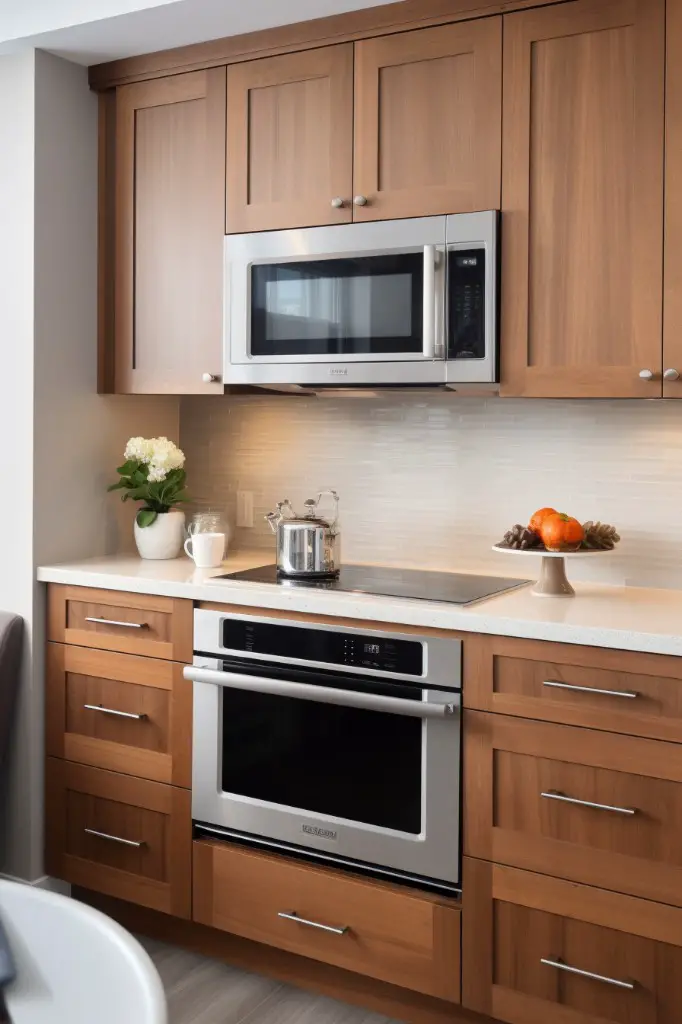
The right choice for you will depend on your kitchen layout, personal preferences, and lifestyle needs. Let’s take a closer look at some of the most popular microwave placement options.
One option is countertop placement. This is ideal if you have limited space in your kitchen or prefer easy access to your microwave while cooking.
However, keep in mind that this may take up valuable counter space and can make the area feel cluttered.
Another option is above-the-counter installations such as wall-mounted shelves or brackets designed specifically for microwaves. This frees up counter space but requires proper installation and may not be suitable for all kitchens due to height restrictions.
Under-cabinet mounting offers a similar solution with less visual impact than an over-the-range installation but still requires adequate clearance between the cabinet bottom and cooktop surface below it.
Over-the-range microwaves combine ventilation with cooking functionality by integrating into range hoods or venting systems above stovetops; however they require professional installation services which can be costly depending on location complexity like ductwork modifications etcetera.
Microwave drawers offer sleek design aesthetics while providing convenient access without taking up valuable counter real estate; these units typically require custom cabinetry work though so plan accordingly!
Safety Guidelines for Microwave Placement
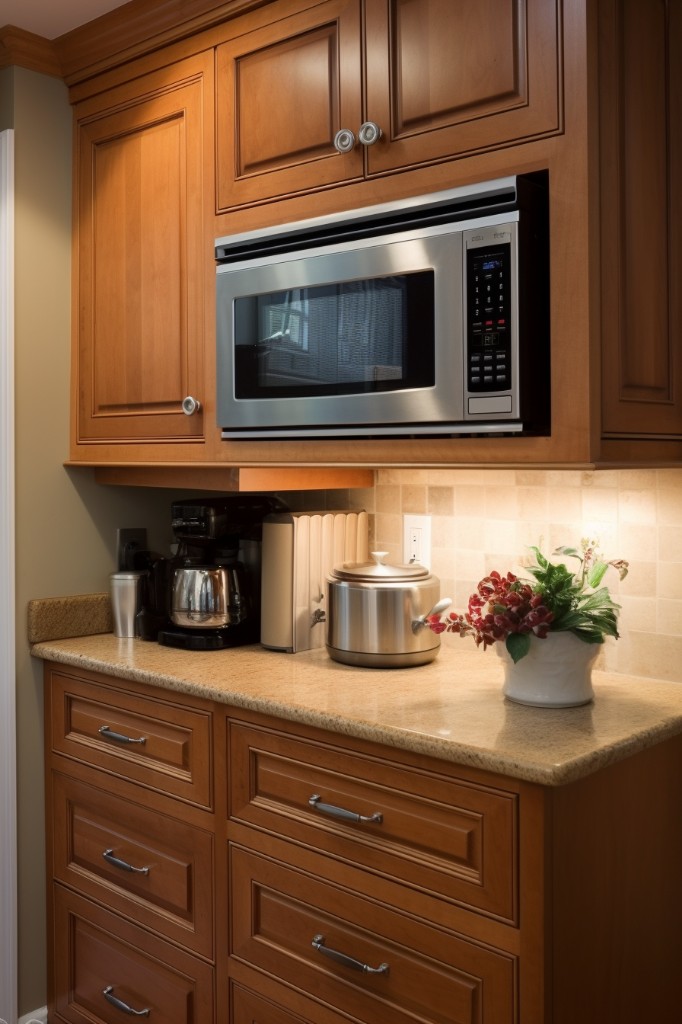
Microwaves emit electromagnetic radiation that can potentially harm human health if not used correctly or placed improperly. Therefore, it’s essential to follow some basic safety guidelines when deciding where to place your microwave.
Firstly, avoid placing the microwave too close to other heat sources such as stovetops and ovens. The heat generated from these appliances can interfere with the functioning of your microwave and cause damage over time.
Secondly, make sure there is enough ventilation around the appliance so that hot air can escape easily. This will prevent overheating and reduce any potential fire hazards.
Thirdly, ensure that you have easy access to both sides of the appliance for cleaning purposes or in case of emergencies like spills or fires.
Lastly, always read and follow manufacturer instructions carefully before installing or using a new microwave oven model.
Countertop Microwave Placement
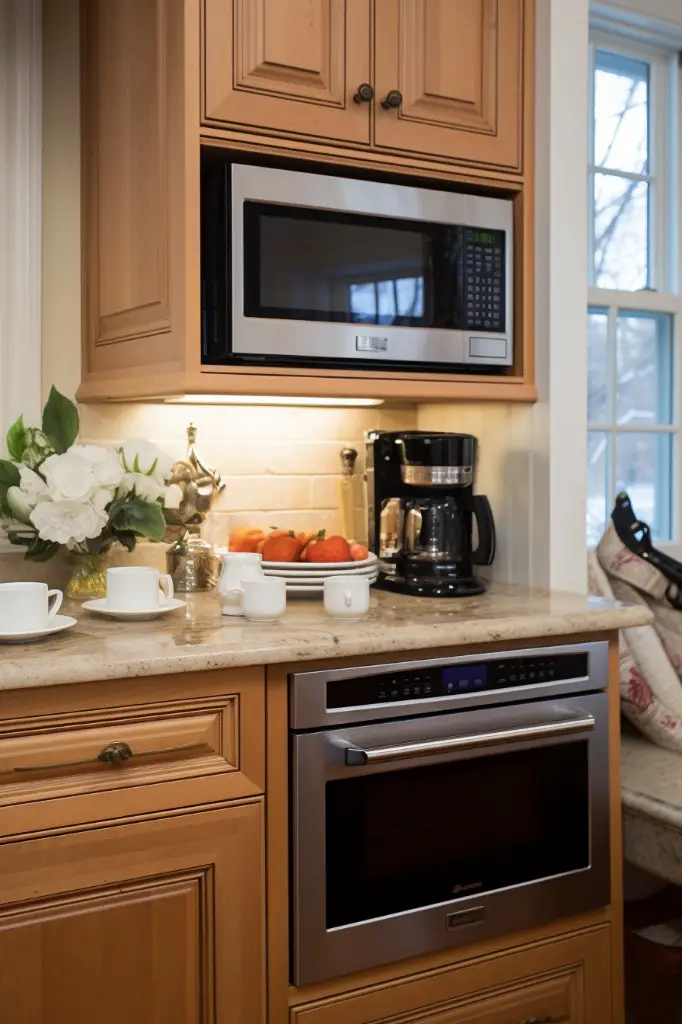
This placement can take up valuable workspace and make it difficult to prepare meals. To maximize efficiency and aesthetics, consider these tips for countertop microwave placement:
- Choose a spot that is easily accessible but doesn’t interfere with meal preparation.
- Keep in mind that microwaves need ventilation space around them to prevent overheating.
- Consider purchasing a compact or mini-microwave if you have limited counter space.
- Use a decorative tray or stand to elevate the microwave off of the counter surface.
Above the Counter Installations
This type of installation involves mounting the microwave on a shelf or cabinet above the countertop, usually at eye level. It’s an excellent choice if you have limited counter space or prefer not to bend down to access your microwave.
When considering this option, it’s essential to ensure that there is enough clearance between the bottom of your cabinet and your cooktop or range hood. The National Kitchen and Bath Association recommends a minimum clearance of 13 inches between these two appliances.
Another factor to consider is whether you’ll need an electrical outlet installed in this location if one isn’t already present. You may also need professional help with installing brackets or support structures for heavier microwaves.
Above-the-counter installations can be both practical and aesthetically pleasing when done correctly.
Under Cabinet Microwave Placement
This placement allows you to keep your countertop free while still having easy access to the microwave. Under cabinet microwaves come in different sizes and styles, so it’s important to measure the available space before making a purchase.
When installing an under cabinet microwave, make sure that there is enough clearance between the bottom of the appliance and your countertop or cooktop surface. Most manufacturers recommend at least 15 inches of clearance for proper ventilation and safety reasons.
To install an under cabinet microwave, you’ll need mounting hardware that typically comes with the appliance or can be purchased separately. Follow manufacturer instructions carefully when mounting it underneath cabinets as improper installation could lead to accidents.
One thing worth noting is that this type of placement may not work well if you have low-hanging cabinets or limited overhead space in your kitchen area since it requires sufficient vertical clearance above where it will hang from below cabinetry.
Over-the-Range Microwave Placement
This type of installation involves mounting the microwave above your stove or cooktop, which frees up valuable countertop space and provides ventilation for cooking fumes.
When considering this placement option, it’s important to ensure that there is enough clearance between the stove and the bottom of the microwave. The minimum recommended distance is 13 inches from the stovetop to avoid any safety hazards.
Another factor to consider when installing an over-the-range microwave is its height. It should be installed at a comfortable height for all members of your household while still allowing easy access for cleaning and maintenance.
One potential drawback with this placement option is that it may not work well in kitchens with low ceilings or if you’re particularly tall as reaching high up can become challenging. Some homeowners find that having their microwaves mounted above their range makes them difficult to use because they are too high up.
Microwave Drawer Installation
These microwaves are designed to fit seamlessly into your cabinetry, providing easy access without taking up valuable counter space.
One of the biggest advantages of microwave drawers is their ergonomic design. Unlike traditional microwaves that require you to bend down or reach up high to use them, these models are installed at waist height for easy access.
This makes them an excellent choice for people with mobility issues or those who want to avoid unnecessary strain on their back and neck.
Another benefit of microwave drawers is that they can be easily integrated into any kitchen design style. They come in various sizes and finishes, so you can choose one that matches your cabinetry perfectly.
However, it’s important to note that installing a microwave drawer requires professional help as it involves electrical wiring and modifications within the cabinet structure itself. It’s not something most homeowners should attempt themselves unless they have experience with this type of work.
Built-in Microwave Wall Units
These microwaves are installed directly into the cabinetry or walls of your kitchen, creating a seamless and integrated appearance. Built-in microwaves come in various sizes to fit different cabinet dimensions.
One advantage of this type of installation is that it frees up valuable counter space while still keeping the microwave within easy reach. It also provides more flexibility in terms of placement since you can choose any location on the wall where there’s enough space to accommodate your chosen unit.
However, installing a built-in microwave requires some carpentry skills and may involve cutting into cabinets or walls. You’ll need to ensure that there’s enough clearance around the unit for ventilation purposes as well as electrical wiring access if needed.
Microwaves in Pantry Cabinets
This option is especially useful if you have limited counter space or prefer to keep the countertop clear of appliances. A pantry cabinet with a built-in shelf for the microwave can also help create a streamlined look in your kitchen.
When considering this placement option, make sure that there is enough clearance around and above the microwave for ventilation and safety purposes. You may need to install additional shelves or adjust existing ones to accommodate the size of your appliance.
Another advantage of placing microwaves in pantry cabinets is that they are hidden from view when not in use, which helps maintain a clutter-free appearance on countertops and other visible areas.
However, keep accessibility top-of-mind when choosing this location as it may not be ideal for everyone’s needs. If you frequently use your microwave throughout the day or have mobility issues that make reaching high shelves difficult, then consider another placement option such as under-cabinet installation or countertop positioning instead.
Integrating With Kitchen Islands
It keeps the appliance out of sight and frees up counter space for food preparation. You can install the microwave in one of two ways: either by placing it on top of the countertop or by integrating it into the island’s cabinetry.
Placing a countertop microwave on your kitchen island is ideal if you want to keep things simple and straightforward. However, this option may not work well if you have limited counter space or prefer a clutter-free look.
On the other hand, integrating your microwave into your kitchen island’s cabinetry creates a seamless look that blends in with its surroundings. This option requires more planning and effort but results in an elegant finish that adds value to any home.
When considering this placement option, ensure there is enough clearance around all sides of the appliance for ventilation purposes as microwaves generate heat while operating.
Open Shelf Microwave Placement
This option is perfect for those who want to keep their countertop space free and showcase their beautiful dishware at the same time. You can place it on a shelf that’s easily accessible or install a pull-out shelf specifically designed for microwaves.
When choosing an open shelf, make sure it’s sturdy enough to hold the weight of your microwave and won’t sag over time. Also, ensure there is enough clearance above and around the appliance so that heat can dissipate properly.
One advantage of this placement option is that you don’t need any special installation skills or tools; just find an appropriate spot on your existing shelves! However, be mindful not to place anything too close to the microwave as it may pose safety hazards when in use.
Corner Placement Ideas
It’s a smart way to save space and keep the appliance out of sight while still being easily accessible. One idea is to install a corner shelf or cabinet above the countertop and place your microwave there.
This will free up valuable counter space while keeping it within reach.
Another option is to use an angled trim kit that allows you to fit your microwave into the corner of two walls seamlessly. This creates a built-in look that blends in with other cabinetry in the kitchen.
However, before choosing this placement option, make sure that there are electrical outlets nearby as well as enough ventilation for proper airflow around the appliance.
Corner placement ideas work best when combined with other storage solutions such as open shelves or cabinets on either side of it so that you can store frequently used items close by without cluttering up limited counter space.
Hidden and Discreet Microwave Solutions
One option is to install the microwave in a pantry cabinet with pull-out shelves. This allows you to easily access the appliance when needed while keeping it concealed behind closed doors when not in use.
Another idea is to integrate the microwave into your kitchen island or peninsula. You can have it installed on one side of the island, facing away from view, or even have it built into a drawer that slides out for easy access.
For those who prefer an ultra-discreet solution, consider installing a wall-recessed microwave unit. These units are designed to fit seamlessly into your kitchen wall and can be covered with custom cabinetry panels that match your existing décor.
Wall-Recessed Microwave Options
This type of installation involves cutting into the wall and creating a recess for the microwave, which is then mounted flush with the surrounding cabinetry. Wall-recessed microwaves can be installed at any height, making them accessible for all members of your household.
One advantage of this option is that it frees up valuable counter space and eliminates clutter on your countertops. Wall-recessed microwaves can blend seamlessly with other appliances or cabinetry in your kitchen, giving it a sleek and modern look.
However, installing a wall-recessed microwave requires some planning ahead as you need to consider electrical wiring requirements before cutting into walls. It’s also important to ensure that there’s enough depth available behind where you plan on placing it so that there won’t be any issues when opening or closing its door.
Microwave Ventilation Considerations
Microwaves generate heat and steam, which can cause moisture buildup and even damage surrounding cabinets or walls if not properly ventilated.
If you’re installing an over-the-range microwave or a built-in wall unit with a vent hood, make sure that the ventilation system is adequate for your cooking needs. The vent should be able to remove smoke, steam, and odors from the air efficiently.
For countertop microwaves or other installations without built-in vents, consider adding an external exhaust fan above the stove area or opening windows during use to allow proper airflow.
Proper ventilation not only protects your kitchen from potential damage but also ensures that you have clean air while cooking.
Accessibility and Ergonomics
You want to make sure that the microwave is easily accessible for everyone who will be using it, including children and those with mobility issues. Placing it too high or too low can cause strain on your back or arms when reaching for items inside.
For optimal accessibility, consider placing your microwave at a height that is comfortable for you and other users. A good rule of thumb is between shoulder and eye level.
This way, you won’t have to bend down or reach up excessively when using the appliance.
Another factor to consider is how close the microwave should be placed near other appliances such as ovens or refrigerators so that they can all work together efficiently without causing any inconvenience while cooking meals.
Aesthetics and Design Preferences
If you have an open-concept kitchen or prefer a minimalist look, you may want to consider hiding your microwave behind cabinetry or integrating it into your island. This will keep the focus on other elements of the space while still providing easy access to this essential appliance.
On the other hand, if you enjoy showcasing unique appliances as part of your decor, placing a colorful countertop microwave on display can add personality and charm to any kitchen. You could also opt for an over-the-range model with sleek stainless steel finishes that complement modern kitchens.
Ultimately, choosing where to place your microwave should be based on both functionality and personal style preferences.
Pros and Cons of Different Locations
For example, placing a microwave on the countertop is convenient but can take up valuable workspace. Mounting it above the stove saves space but may not be practical for shorter individuals or those with mobility issues.
Installing an under-cabinet microwave frees up counter space while keeping it within easy reach. However, this option requires additional installation work and may limit cabinet storage below.
Over-the-range microwaves offer ventilation options and save counter space by combining a range hood with a microwave unit. But they can be difficult to access for shorter people or those using mobility aids like wheelchairs.
Microwave drawers provide sleek design options that blend seamlessly into cabinetry while offering accessibility at waist height. However, they tend to be more expensive than other placement options.
DIY Microwave Installation Tips
First and foremost, make sure you have the necessary tools and equipment for the job. You’ll need a drill with appropriate bits, screws or brackets for mounting your microwave (depending on where it will be installed), measuring tape, leveler tool to ensure that everything is straight and even.
Before starting any installation process, always read through the manufacturer’s instructions carefully. This will help you understand what needs to be done step-by-step so that nothing is missed or overlooked during the process.
Another important consideration when installing your own microwave is safety precautions. Make sure all electrical connections are secure before plugging in your appliance; if unsure about wiring issues consult an electrician beforehand.
Don’t hesitate to ask for help from someone who has experience with similar installations if needed – two heads can often work better than one! With these tips in mind along with our other placement ideas above – finding just the right spot for your new kitchen gadget should be easy as pie!
FAQ
Where should a microwave be placed in a kitchen?
A microwave should be placed in a kitchen close to the countertop, stove top, and fridge, ensuring bench space is nearby for convenience.
How far should a microwave be from the countertop?
A microwave should ideally be 18 inches above the countertop, considering a standard cooktop height of 36 inches and the bottom of the microwave at 54 inches above the floor.
Should you put a microwave in a cabinet?
No, you should not put a microwave in a cabinet, as countertop microwaves have vents built into the back that need proper air circulation.
Can you put a microwave on a kitchen counter?
Yes, you can put a countertop microwave on a kitchen counter, as they are not designed for enclosed spaces like cabinets.
What are the safety considerations for microwave placement in a kitchen?
Safety considerations for microwave placement in a kitchen include ensuring adequate ventilation, maintaining appropriate distance from combustible materials, and positioning it at a safe reachable height for users.
Are there any advantages of installing a built-in microwave compared to a countertop model?
Built-in microwaves save counter space and provide a more integrated, streamlined appearance in the kitchen.
How can the kitchen layout influence the ideal positioning of a microwave?
The kitchen layout influences the ideal positioning of a microwave by determining the most convenient and accessible location, considering factors such as counter space, proximity to electrical outlets, and ease of use for the user.
